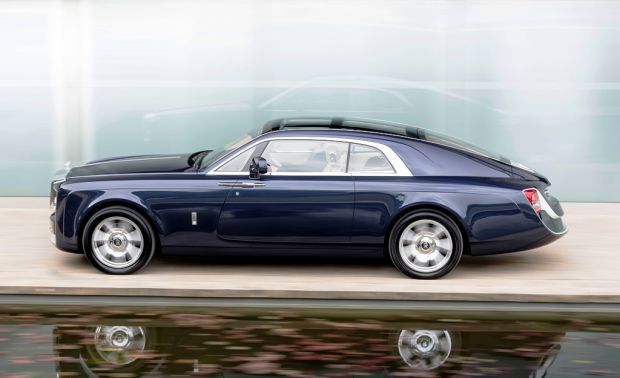Back

Rolls-Royce Coachbuild: A glorious legacy. A spectacular future
25th May 2021
Although in theory a coachbuilt Rolls-Royce could be any shape the customer desired, in practice there were constraints. Rolls-Royce motor cars were designed on proven technical principles that were, in the minds of the Company’s founders, unarguable and inviolable. By insisting on fixed dimensions for the bulkhead behind the radiator, they were able to ensure the bodywork maintained the essential proportions that visually identified it as a 'true' Rolls‑Royce.
Those proportions remain enshrined in the marque's design tenets to this day. Examine any contemporary Rolls-Royce and it exhibits the 2:1 ratio of body height to wheel diameter first established with the Silver Ghost in 1907. The body shape is defined by three fluid lines running the length of the car: the ‘waft line’ that gives the car its sense of movement; the ‘waist line’ that lends it purpose and presence; and the silhouette, which expresses its individual character.
These basic principals allow considerable scope, as evidenced by the highly distinctive forms of Phantom, Ghost, Wraith, Dawn and Cullinan. Patrons and designers therefore enjoy considerable creative freedom in a coachbuilding project, within these fundamental design parameters. It will, after all, bear the Spirit of Ecstasy figurine above the grille – another immutable principle – so must be a genuine Rolls‑Royce worthy of the name, and recognisably so.
Bespoke IS Rolls-Royce and has been central to the marque's offering and experience since production began at Goodwood in 2003. It has proved phenomenally successful, with commissions increasing year-on-year. The first quarter of 2021 saw the landmark moment when, for the first time, every single motor car built at the Home of Rolls-Royce, across the entire model family, included Bespoke elements. It is the unique vision and capabilities of the Bespoke Collective that makes Rolls-Royce a true luxury house, not merely an automotive manufacturer.
Patrons have always been able to personalise their motor car's appearance in myriad different ways – beginning with a choice of 44,000 paint colours. But their options for altering its overall outline have historically been limited by the underlying structure. For this reason, fully coachbuilt Rolls-Royce motor cars have been rarities in the modern era; much of the sensation around Sweptail arose precisely because it was such a unique event.
It was made possible by a seismic change in the marque's manufacturing process, which was first deployed to magnificent effect, and global acclaim, in the eighth-generation incarnation of its pinnacle product, Phantom.
The current Phantom was the first car to be built on the marque's proprietary structure. This is an all-aluminium spaceframe chassis, designed and engineered from the ground up to be scalable for a range of different Rolls-Royce models. In essence, it creates four fixed points at each corner of the motor car. The distance between them can be whatever the designers and engineers want it to be: bulkhead, floor, crossmember and sill panels can all be stretched or shrunk or increased in height according to the product. The concept has proved brilliantly successful, forming the basis for the Cullinan SUV launched in 2019, and in 2020, the new Ghost.
Crucially, this flexibility opens up new possibilities for coachbuilding. By moving away from monocoque construction to something closer to a traditional rolling chassis, Rolls-Royce has reacquired the freedom to construct almost any body shape its patrons can imagine, constrained only by fundamental design and engineering requirements.
This means that Rolls-Royce and its patrons can now look beyond Bespoke and build the car itself, to commission. In this way, it is perfectly aligned with a lifestyle in which the client's investments in luxury, from property, clothing and jewellery to works of art, yachts or private aircraft are personal, individual and unique.
With the Architecture of Luxury, the marque has ushered in a new coachbuilding movement that encompasses both highly sophisticated 21st Century technology and materials, and a tradition extending back more than 100 years. It is both evolutionary and revolutionary.
In 2013, Rolls-Royce was commissioned to create a coachbuilt two-seater coupé featuring a large panoramic glass roof, inspired by the beautiful coachbuilt motor cars from the marque’s golden era in the 1920s and 1930s.
The first fully coachbuilt Rolls-Royce of the modern era, the Sweptail pictured, the car’s defining feature is the raked rear profile, the roof-line tapering in a sweeping gesture to a ‘bullet-tip’ that houses the centre brake light. The coachbuilt bodywork wraps under the car with no visible boundary to the surfaces like the hull of a racing yacht. The underside of the motor car describes a progressive upward arc at the rear departure angle, producing the swept tail that gives the car its name.
With its clean lines and grandeur, and contemporary, minimalist handcrafted interior, Sweptail caused an international sensation when it was revealed in 2017. Four years in the making, it is now regarded as a true modern classic and the world’s greatest two-seater intercontinental tourer.
